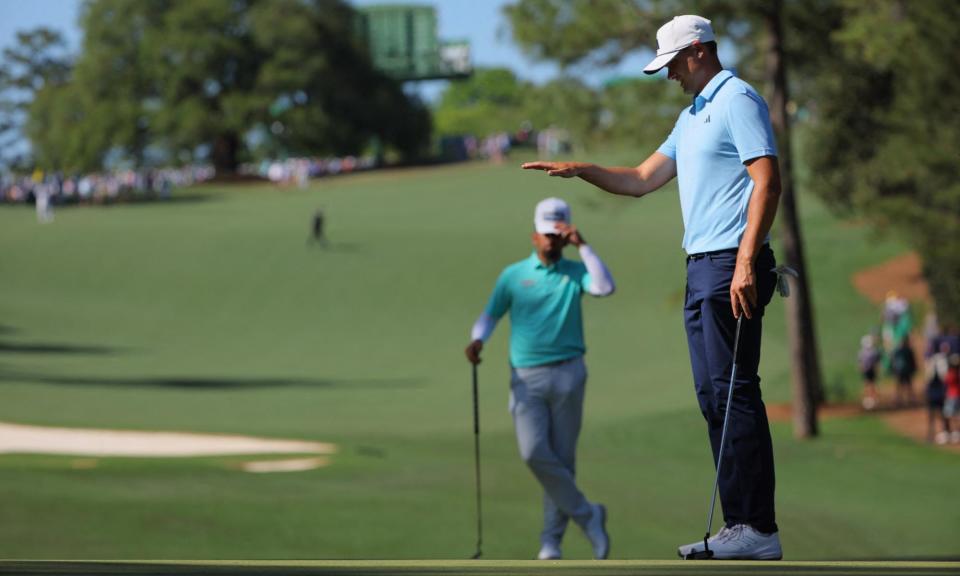Different strokes of Ludvig Åberg and Matthieu Pavon tell their stories

There are 20 ways to make the Masters, from winning the thing, or any other of a dozen leading competitions, to making it into the top 50 of the world rankings in the week before the tournament starts.
The official listings will tell you that Ludvig Åberg and Matthieu Pavon both came the very same way, by route No 17, “Individual winners of PGA Tour events that award a full-point allocation, from previous Masters to current Masters”. Åberg did it by winning at the RSM Classic at St Simons Island in November, and Pavon by winning the Farmers Insurance Open at Torrey Pines two months later.
They stepped out on to the 1st tee together at just after two on Friday afternoon, two European golfers riding high on the leaderboard, and paired together in the penultimate round. Neither of them had ever played the Masters before, but Åberg was two under, four shots off the lead, and Pavon was one shot further back.
Related: The Masters: day three at Augusta – live
Really, though, the two men had taken very different roads to this moment. Åberg, 24, is just about the hottest young golfer on the tour. He turned pro 10 months ago, and in that time he has won two tournaments, been part of a winning Ryder Cup team, and earned as much money as Pavon, 31, has in the entirety of the last decade. Åberg joined the tour right after graduating from Texas Tech, where he was ranked the world’s best amateur golfer, and became the second man in history, after Jon Rahm, to win the Ben Hogan award, given to the best collegiate player, twice in a row.
Pavon has also won two top-tier tournaments, only it took him 10 years to do it. He turned professional in 2013, did two years on the Alps Tour, made his way through Q school on to the Challenger circuit and finally made the European Tour, where he peeled off a whole lot of third-place finishes without ever winning anything. He finally made it to the PGA Tour after he rattled off four birdies in four holes at the finish of the DP Tour Championship last year. Right now, he’s the best golfer in France, and will be the face of the game there during the Olympics later this summer.
Pavon’s father, Michel, was a professional footballer, played in the midfield for Toulouse and Bordeaux, and went on to become the latter’s manager too. His mother, who is a golf instructor, brought Michel here to Augusta in 2009 as a 40th birthday present. Pavon tells a story about how she buried a one euro coin out by the driving range here and told her son to come dig it up for her sometime in the next decade. It took him 15 years, but he had finally made it. Along the way he nearly quit playing because he had the chipping yips, till his coach fixed it by teaching him a cross-handed grip.
He looks like a man who has done a bit of living. He has a beard, a broken nose, and he chews his tees while he’s waiting to play. He hustles around the course, but he doesn’t have a whole lot of game. He hits a tidy little fade and is a dab hand with his putter, and he has, according to his friend and fellow pro Mike Lorenzo-Vera, “a huge pair of balls”.
Åberg, on the other hand, is a tall, blond, streak of sweatless Swede. It was getting on for 30C in the sun, but he didn’t seem to shed a single bead. He has the air of a man whose life hasn’t included many harder decisions than whether or not he wants syrup with his pancakes. His golf is young, splendid and godly, and when he catches the ball cleanly, as he did with his second shot on Augusta’s ferociously difficult 5th, you don’t even need to watch the ball to know where it’s going. The sound tells you everything you need.
Even his bad shots hardly seem to bother him. When Åberg finally got one wrong and walloped his tee shot into the trees on the long uphill 8th, he arrived, three minutes later, with a breezy inquiry of “no one’s hurt?” and a half-eaten club sandwich in hand. He finished, slowly, while he was also chewing over what to do next. “A little 5 iron,” he decided. He clipped it 200 yards up the fairway, trimming a couple of ivy leaves off a nearby tree with his follow-through. Five minutes later, he was standing over a birdie putt from 13ft.
Åberg didn’t make that one, but he did pick up four others, and briefly got to the top of the leaderboard before he made back-to-back bogeys with a couple of three-putts at 14 and 15. Pavon, meanwhile, was struggling around Amen Corner, where he dropped shots at both 11 and 12. Åberg ended up scoring 70, Pavon 73. But the biggest difference between them wasn’t the score. It was that Åberg has the easy confidence of a young man who believes he has countless days like this ahead of him. Pavon had all the nerves of an older pro who knows all too well just how precious they are.

